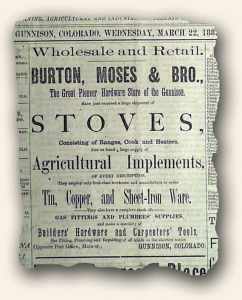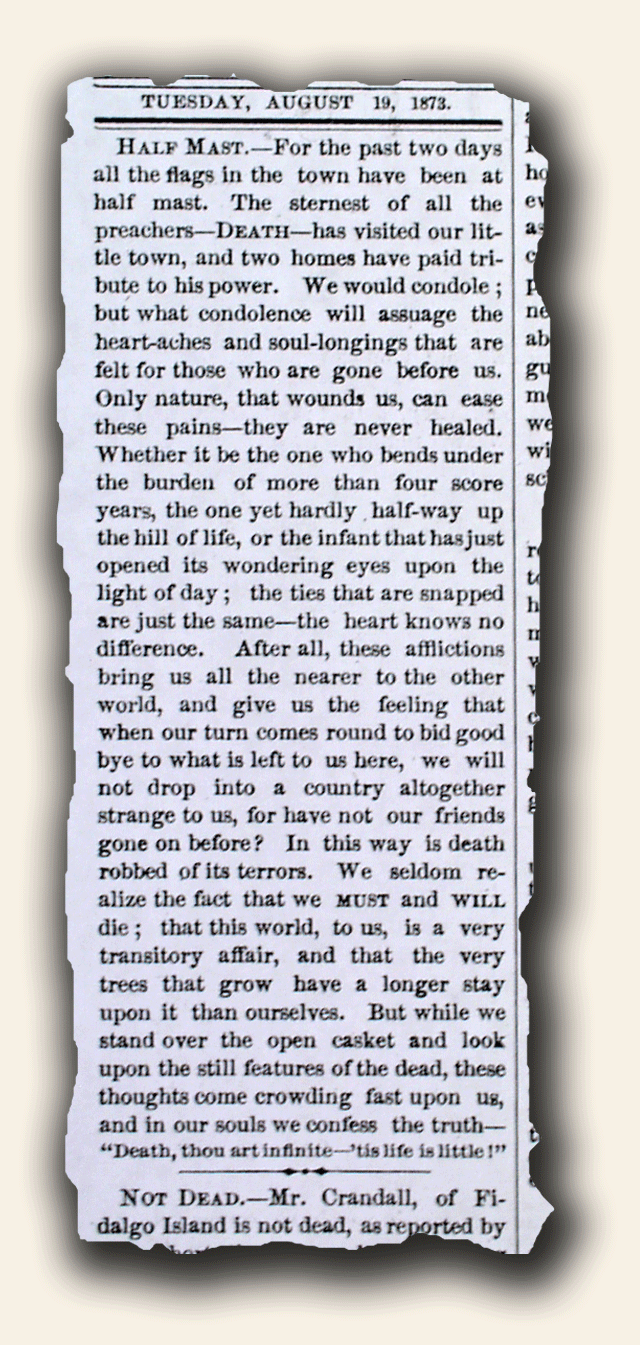Mining town of Gunnison, Colorado…
March 3, 2011 by TimHughes · Leave a Comment
 Many of the newspapers held in our “Old West” category have a look very similar to most newspapers of the day, but have histories which tell an interesting story of the Old West. The newspapers from these towns offer a window into daily life and are much more interesting when the story of the town is known. From time to time we will provide a glimpse into the past of some of the towns in our Old West inventory.
Many of the newspapers held in our “Old West” category have a look very similar to most newspapers of the day, but have histories which tell an interesting story of the Old West. The newspapers from these towns offer a window into daily life and are much more interesting when the story of the town is known. From time to time we will provide a glimpse into the past of some of the towns in our Old West inventory.
We offer many issues of the “Gunnison Daily Review” from the early 1880’s. It was named for John W. Gunnison who first explored the area looking for a transcontinental railroad route, even though he only stayed in the town for 3 days of his entire life.
Gunnison first began to boom in the 1870’s along with the rush of mining activity in Colorado. The Ute Indians had been forced out of the area and many ranchers, traders and miners began to move in. Gunnison became the official seat of Gunnison County on May 22, 1877. In 1880 the railroad arrived, welcomed by not only miners but by the ranchers and farmers as well.
Gunnison saw one of the quickest boom and bust cycles ever as the mines and railroads came to town in the 1880s along with all the normal business increases it created. But, by 1883 a mining bust had come to town and half of the population departed. It seems the precious ore veins that were discovered turned out to be shallow and low producing. It was also at this time when the Earps, of Tombstone, and Texas Jack set up camp on the outskirts of Gunnison. Eventually, Wyatt took over a faro game (gambling card game) at a local saloon.
Today Gunnison is the home of some 5500 residents.
(credit: Wikipedia & the Gunnison Chamber of Commerce)
Lamenting the handwritten word…
December 4, 2010 by TimHughes · Leave a Comment
In today’s world of email, instant messaging, and twitter, there are many who lament the “old days” when people took the time to type out a letter, sign it, and use a stamp & envelope to get it to its destination. This item, found in “The Townsend Messenger” of Montana, issue date of March 18, 1892, takes that “lament” back one step further when the typewriter replaced the handwritten note.
A rare report… Wild Bill Hickok…
November 22, 2010 by TimHughes · 3 Comments
Some reports have gained greater notoriety long after the event happened, particularly those of the Old West which have been romanticized by television, movies and countless books on the era. The gunfight at the O.K. Corral is one, and the report of the killing of Wild Bill Hickok is another. Neither are commonly found in newspapers of the day with the Hickok report being one of the more difficult to find, and typically on a brief report when found.
We recently came across the “New York Herald” of August 13, 1876 with the report & thought it worth sharing:
The allure of the Old West…
July 26, 2010 by TimHughes · Leave a Comment
While few of us will have the opportunity to visit some of the fascinating old mining towns of the Old West, holding a newspaper from a ghost town’s hey day can be the next best thing. And with a little knowledge about the town, a newspaper from the neighborhood press takes on added appeal and intrigue.
 With this in mind I will, from time to time, offer some background information on the towns from which some of our Old West newspapers came. And I’ll start with an issue with an interesting title, the “Owyhee Avalanche” of Silver City, Idaho.
With this in mind I will, from time to time, offer some background information on the towns from which some of our Old West newspapers came. And I’ll start with an issue with an interesting title, the “Owyhee Avalanche” of Silver City, Idaho.
Silver City is one of the few old mining towns that did not burn down or become commercialized into a modern city. Visiting Silver City is like going back into history. The Idaho Hotel is as it was 100 years ago with a few modern amenities. Rugged and picturesque, the 8,000 feet-high Owyhee Mountains surround Silver City, elevation 6,200 ft. The history-filled town contains about seventy-five structures that date from the 1860’s to the early 1900’s.
During its “heydays”, Silver City had about a dozen streets, seventy-five businesses, three hundred homes, a population of around 2,500, twelve ore-processing mills, and was the Owyhee County seat from 1866 to 1934. Some of the largest stage lines in the West operated in the area, and Silver City had the first telegraph and the first daily newspaper in the territory in 1874.
More that two dozen camps provided shelter, supplies and amusement for the thousands of people who came to the mountains seeking their fortunes in one way or another. The ruins of some of these can still be found though nature is reclaiming most of them at an accelerated rate. Almost a dozen cemeteries and many more remote burial sites attest to the hard and sometimes dangerous and violent lives led by many. Hundreds of mines pock-mark and honeycomb the mountains; one had upwards of seventy miles of tunnels laboriously hand-dug through it. Between 1863 and 1865, more than two hundred and fifty mines were in operation and hundreds more were developed thereafter. At least sixty million dollars worth of precious metals were taken from the area. (credit: historicsilvercityidaho.com)
Click HERE for some photos of present-day Silver City.
It caught my eye…
March 6, 2010 by TimHughes · Leave a Comment
The front page of the “Weekly Missoulian” newspaper from Missoula, Montana Territory, December 12, 1873 has an article titled: “The Value of a Newspaper” which logically caught my eye. Although the item had nothing to do with the value of an historic newspaper, it does say much about the relative cost to subscribe to a newspaper in the 1870’s, and has a nice story associated with it as well. Enjoy.
I have typically found Old West newspapers to have some of the more interesting tidbits of any era or region. We have hundreds to choose from for your browsing.
Writing styles have changed through the years…
February 27, 2010 by TimHughes · Leave a Comment
This nice piece concerning death, published in “The Semi-Weekly Argus” newspaper from Port Townsend, Washington Territory, Aug. 19, 1873, is a great example of how differently–and often beautifully–writing styles were over 100 years ago.
Much of the fun of collecting newspapers is enjoying a different style of writing, whether the piece is historical or just an ordinary comment of the day, as is the case with this item.
How to be a cowboy: The protocol in 1882…
August 13, 2009 by TimHughes · Leave a Comment
 It’s interesting how the stereotype of the cowboy as created by Western movies and the lore generated by Western writers can hold true to reality. This was my thought when I can across an interesting tidbit from a Yuma, Arizona, newspaper of January 7, 1882—from a truly Western town at the high point of the Wild West era:
It’s interesting how the stereotype of the cowboy as created by Western movies and the lore generated by Western writers can hold true to reality. This was my thought when I can across an interesting tidbit from a Yuma, Arizona, newspaper of January 7, 1882—from a truly Western town at the high point of the Wild West era:
“He Wanted to be a Cowboy”
A youth recently went all the way from Chicago to New Mexico to become a cowboy. When there he explained his desire to a typical mountaineer whom he met and asked for instructions in the role he had wished to assume. Grasping him by the hand the mountaineer said: “You want to get a buckskin suit with plenty of fringe, a pair of high boots and a pair of high spurs. Then you want to get a broad-rimmed hat–the broader the better; two fort-fives, a knife, a Winchester rifle and a horse; then you want to get drunk and get on your horse; then take the reins in your teeth, a revolver in each hand, and go down the street at a full run, shooting at every jump. then come back and yell as loud as you can: ‘My name is ______ and I’m stinking for a fight; I’m a sone-of-a-gun from the plains.’ After that you will be a cowboy.” The picture is duly referred to the cowboy’s prototype in Western Missouri.”
They put it in print… I wonder why he did it?
December 8, 2008 by TimHughes · Leave a Comment
 As I’ve mentioned before, the curious, odd tidbits which are found in early newspapers provide a fascinating insight into life of a bygone era, and some chuckles as well. Here is an inconspicuous report in The Salinas City Index from California, dated June 5, 1873:
As I’ve mentioned before, the curious, odd tidbits which are found in early newspapers provide a fascinating insight into life of a bygone era, and some chuckles as well. Here is an inconspicuous report in The Salinas City Index from California, dated June 5, 1873:
“An Indiana woman is mad because her husband took her very best sheet to hang himself, when there was an old cothes line in the cellar which was good enough for the purpose. She says he was always to extravagant, and too lazy to go into the cellar for anything.” It’s also interesting to note the improper use of “to”. Enjoy!




